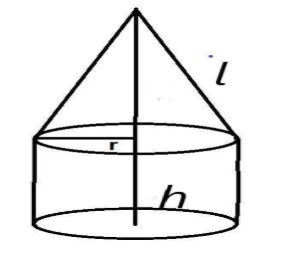
The total surface area of the given solid figure is –


Answer
506k+ views
Hint – Use the formula, total surface area = curved surface area of cone + curved surface area of cylinder + area of base. And then solve.
Complete step by step answer:
According to the question, we have to find the total surface area of the given figure.
So, we can say the total surface area of the figure = curved surface area of cone + curved surface area of cylinder + area of base.
Now, the curved surface area of cylinder $CS{A_1} = 2\pi rh$.
Curved surface area of cone, $CS{A_2} = \pi rl$.
And, area of base, $B = \pi {r^2}$.
Here, r = radius, h = height, l = slant height.
So, now the total surface area of the given figure will be, $A = CS{A_1} + CS{A_2} + B$,
Keeping the values of $CS{A_1} = 2\pi rh$, $CS{A_2} = \pi rl$, $B = \pi {r^2}$in A, we get-
$
A = 2\pi rh + \pi rl + \pi {r^2} \\
= \pi r(2h + l + r)sq.units \\
$
Hence, the total surface area of the given figure is, $ = \pi r(2h + l + r)sq.units$.
Note – While solving such types of questions, see the figure is made of what combinations, as here in the given question, the figure contains a cone and a cylinder. Hence, the total surface area will be the sum of the curved surface area of both the figure and the area of the base.
Complete step by step answer:
According to the question, we have to find the total surface area of the given figure.
So, we can say the total surface area of the figure = curved surface area of cone + curved surface area of cylinder + area of base.
Now, the curved surface area of cylinder $CS{A_1} = 2\pi rh$.
Curved surface area of cone, $CS{A_2} = \pi rl$.
And, area of base, $B = \pi {r^2}$.
Here, r = radius, h = height, l = slant height.
So, now the total surface area of the given figure will be, $A = CS{A_1} + CS{A_2} + B$,
Keeping the values of $CS{A_1} = 2\pi rh$, $CS{A_2} = \pi rl$, $B = \pi {r^2}$in A, we get-
$
A = 2\pi rh + \pi rl + \pi {r^2} \\
= \pi r(2h + l + r)sq.units \\
$
Hence, the total surface area of the given figure is, $ = \pi r(2h + l + r)sq.units$.
Note – While solving such types of questions, see the figure is made of what combinations, as here in the given question, the figure contains a cone and a cylinder. Hence, the total surface area will be the sum of the curved surface area of both the figure and the area of the base.
Recently Updated Pages
Two men on either side of the cliff 90m height observe class 10 maths CBSE

What happens to glucose which enters nephron along class 10 biology CBSE

Cutting of the Chinese melon means A The business and class 10 social science CBSE

Write a dialogue with at least ten utterances between class 10 english CBSE

Show an aquatic food chain using the following organisms class 10 biology CBSE

A circle is inscribed in an equilateral triangle and class 10 maths CBSE

Trending doubts
Why is there a time difference of about 5 hours between class 10 social science CBSE

Write a letter to the principal requesting him to grant class 10 english CBSE

What is the median of the first 10 natural numbers class 10 maths CBSE

The Equation xxx + 2 is Satisfied when x is Equal to Class 10 Maths

Which of the following does not have a fundamental class 10 physics CBSE

State and prove converse of BPT Basic Proportionality class 10 maths CBSE




